Does the word “Serengeti” conjure up images of Africa, wild animals and endless plains? What about “The Great Migration”? Do you see thousands of wildebeests and zebras heading toward a river crossing? Well, for the past year, I was consumed with planning a safari (and more) for the wife and me because I have always wanted to see the Serengeti and experience the Great Migration. My wife, Elaine, would have been happy with a trip to Italy.
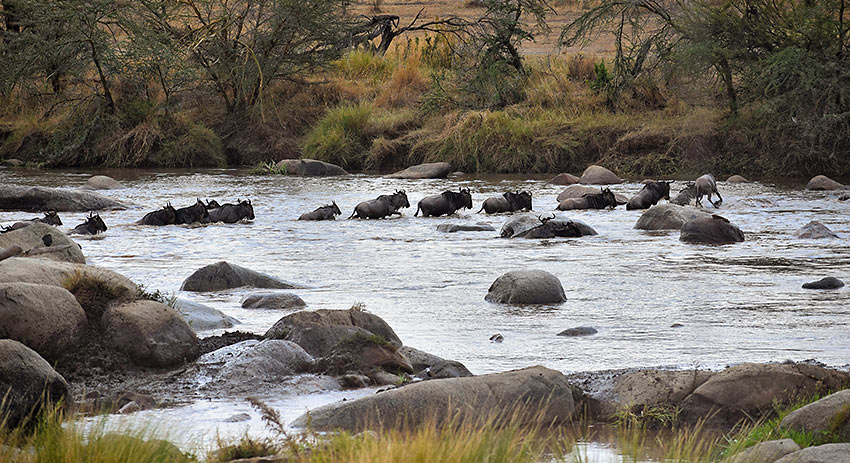
My dream became a reality at the end of July 2017 when we boarded a KLM flight to Kilimanjaro in Tanzania. After a 10-hour flight from Los Angeles to Amsterdam, a short layover in Amsterdam, and another nine-hour flight to Tanzania, we arrived at Kilimanjaro International Airport about seven in the evening – one day ahead of when we left LA. I knew we were in for many unforeseen experiences when we deplaned from a Boeing 777 via stairs (no jetways here) and looked back at the massive plane from the tarmac thinking that this adventure was going to be as huge as the plane beside us.
There are quite a few countries in east and south Africa that host safaris, but only two that can claim the Great Migration (Tanzania and Kenya) and really only one that is home to the Serengeti (Tanzania), even though the plains along the southern border of Kenya, that run along the northern part of the Serengeti in Tanzania, known as Maasai Mara, are also part of the Serengeti Eco-system. But by all accounts, the Great Migration, probably the greatest annual movement of animals on the planet, happens in Tanzania.
As a point of reference, the Serengeti is a national park about the size of the state of Connecticut, and has no paved roads. The Land Cruiser is the vehicle of choice for all the safari companies we saw while in the bush and at the tented camps (in which) we stayed in. The roads are brutal on these vehicles (and on the people inside), but they are incredibly sturdy and surprisingly comfortable. Nearly all have pop-up tops that remain in the up position during game drives to provide its passengers the ability to stand up at any time to take in the scenery or take pictures. Getting out of the vehicle while on a game drive or traveling around in the bush is highly discouraged except at certain locations when cleared by your driver or at designated locations. One must remember that although the animals are used to seeing vehicles during the day, they are wild animals, not in a zoo, and there are no fences.
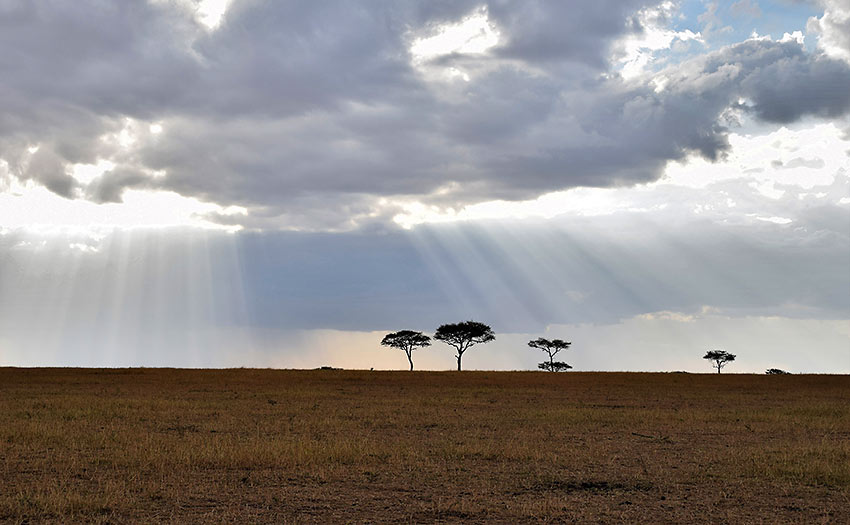
Since I enjoy researching and scheduling my own travels, my safari planning took me to the Internet and several safari blogs which helped me understand what the trip would entail as well as choosing the right safari company and the best time to go. All the travel sites will tell you that there is no bad time to go on safari, which is essentially true. So, if the Great Migration is on your bucket list, it can be seen all year-round at different locations, mostly in Tanzania. But if you want to see the river crossings where thousands of wildebeests and a few of the bravest zebras cross the Mara River, home to the largest crocodiles in Africa – the Nile crocodile – the northern hemisphere’s summer months are the best time to go.
Suffice it to say that I could spend a considerable amount of time on how I ended up choosing the safari company, tented camps (some call it glamping) and when to go, but I will only say that time, money and personal preference must all be considered since there are both budget safaris and luxury safaris. Since I considered this a once-in-a-lifetime trip, I opted for luxury.
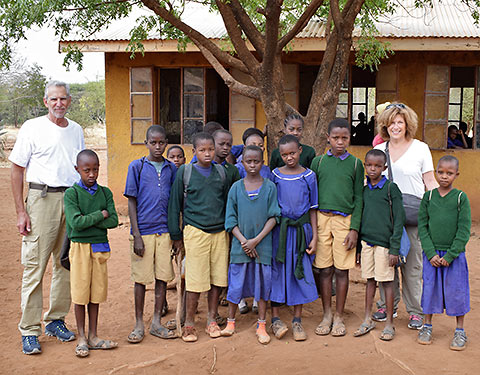 We spent our first and second nights in the small town of Moshi at the base of Mount Kilimanjaro, just east of the larger city of Arusha where most Tanzania safaris begin, just to acclimate to the time difference and getting over jet lag. Most importantly, we met our driver, Said, from Pristine Trails, our safari company. Soon we climbed into our Land Cruiser for the next eight days of travel through Tanzania.
We spent our first and second nights in the small town of Moshi at the base of Mount Kilimanjaro, just east of the larger city of Arusha where most Tanzania safaris begin, just to acclimate to the time difference and getting over jet lag. Most importantly, we met our driver, Said, from Pristine Trails, our safari company. Soon we climbed into our Land Cruiser for the next eight days of travel through Tanzania.
Some people with limited time or a dislike of rough roads and lots of dust, may choose to fly into the Serengeti on a small bush plane, but I wanted to experience driving from location to location, tented camp to tented camp, which essentially results in a continuous game drive since there are animals of all types everywhere in the Serengeti and surrounding areas.
After making a brief stop at Said’s school outside of Arusha to deliver soccer balls and frisbees that we had brought with us as gifts for the kids, we were off to our first destination – the Tarangire National Park – to begin our quest to see the “Big Five” – lions, leopards, rhinoceros, elephants and buffalos.
Tarangire National Park lies to the southeast of the Serengeti and is known to house a large population of resident animals so we were not disappointed by our first venture into the bush. In our day and a half in Tarangire, we had our first sightings of lions, leopards, wildebeests, zebras, elephants, giraffes, impalas, several varieties of gazelles, baboons, dik diks (the smallest antelope in Africa), waterbucks, a few buffaloes and a large variety of birds.
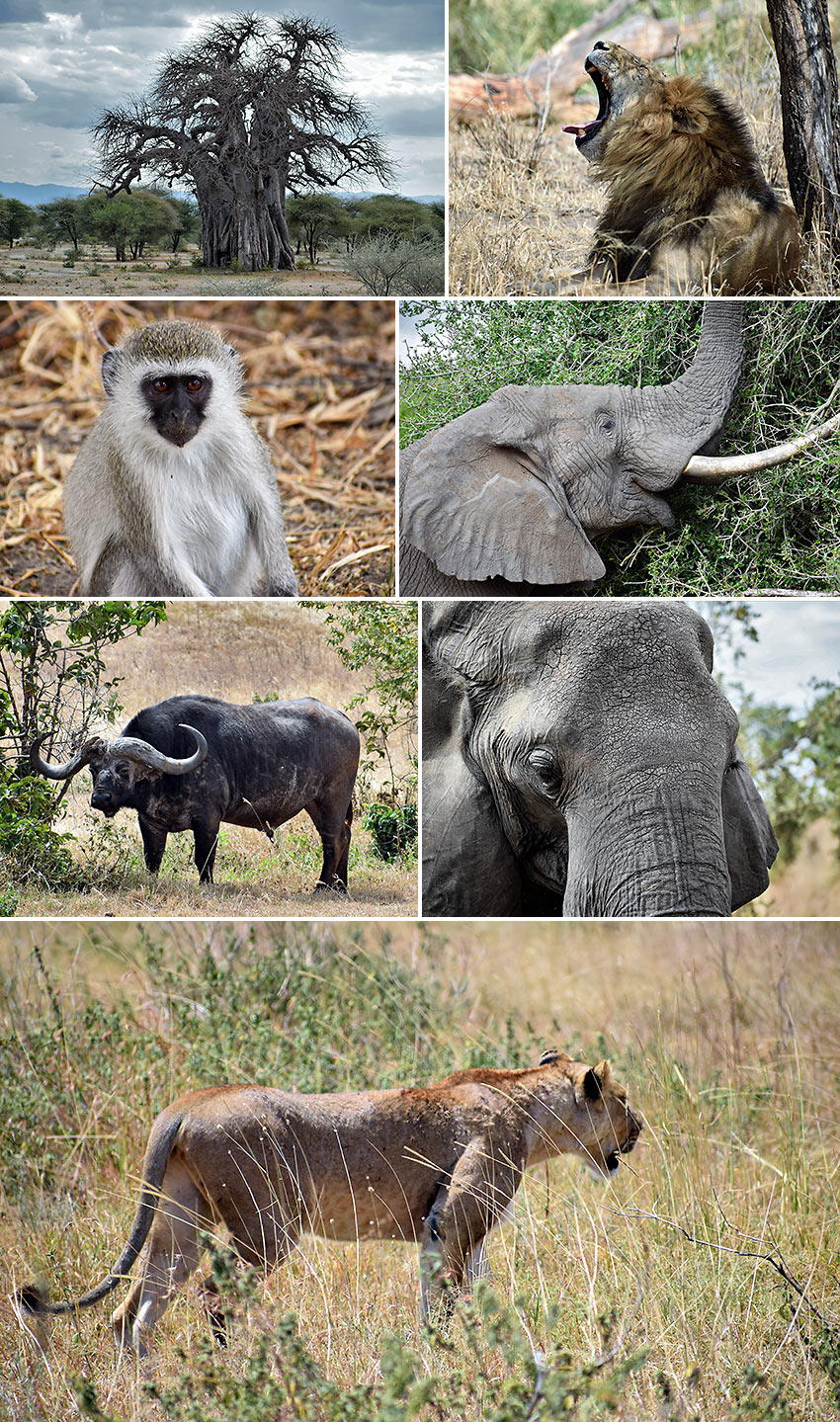
We also saw the famous baobab trees which have huge trunks and branches that look like tree roots. The myth behind the baobab tree is that the gods were angry with the natives and turned the tree upside down so that its branches look like roots reaching for the sky.
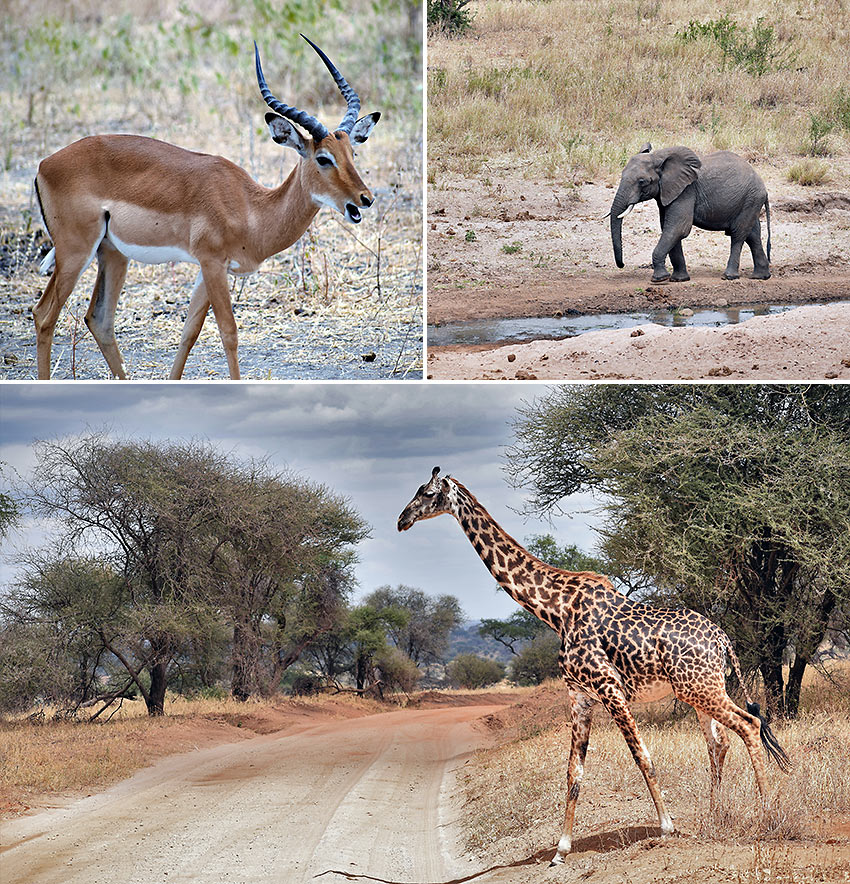
Every animal we saw presented a photo op, so I have an abundance of pictures of these animals, but by the time we left Tarangire for the Ngorongoro Crater, I didn’t think that some of the animals I had photographed were so special anymore. I couldn’t have been any more wrong.
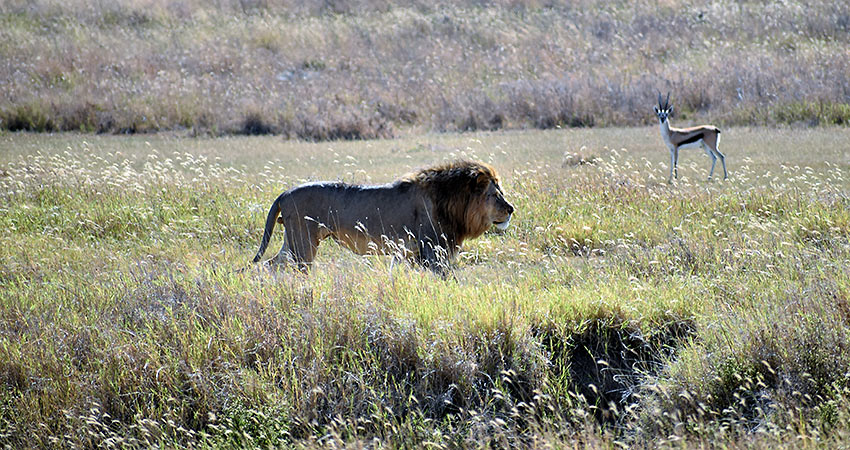
Being up close to many of these animals is simply fascinating. After taking picture after picture of the same animals, I learned to put my camera down and just enjoy watching these animals in their natural environment. For the most part, most of the animals – predators included – get along and go along during the day as they share the same space in the bush. Most of the predators – the big cats, hyenas, jackals – hunt at night for their food. Many of the animals are herbivores which means they eat the grasses in the plains. As the grasses are consumed by the thousands of animals, they then migrate to new areas where the grasses are more plentiful. Hence, the natural wonder behind the Great Migration. More on that later.
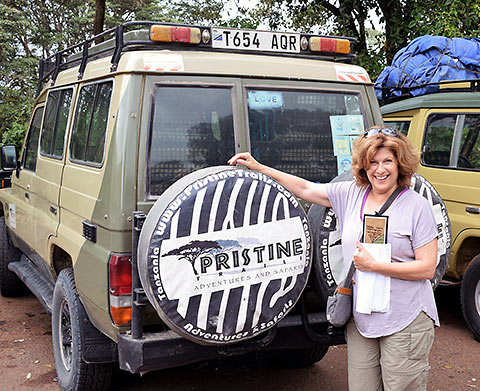 As I noted before, the clear majority of safari vehicles are Toyota Land Cruisers that are customized for the rough and dusty gravel and dirt roads along the safari route.
As I noted before, the clear majority of safari vehicles are Toyota Land Cruisers that are customized for the rough and dusty gravel and dirt roads along the safari route.
There simply are no paved roads to be found once one enters the bush. Also, most of the vehicles have front seats for the driver and a passenger (hardly anyone rides shotgun), and up to three additional rows of seats depending on the size of one’s group and/or the type of safari booked. The vehicles of choice have pop-up roofs that when in an open position, allow the passengers in the second and third rows to stand up inside for unobstructed animal viewing and photos.
Since Elaine and I were on a private safari, we were in a vehicle with two rows behind the driver. The empty row of seats afforded us a bit more room to move around, plus extra space for our luggage which consisted of airplane carry-on bags and a soft sided duffle bar. Safari is definitely one trip where you need to travel light. Most of the tented camps have a laundry service, although in one camp our laundry seemed to come back dirtier than when we sent it in.
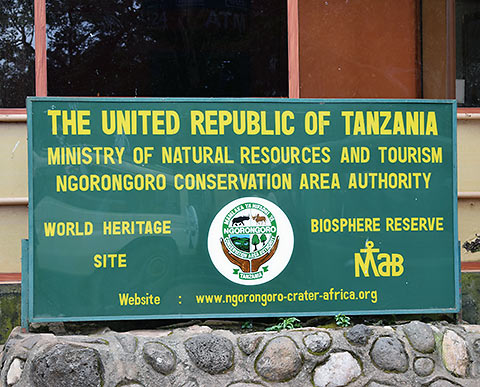 There are safari visitors who prefer to fly from bush camp to bush camp, avoiding the rough roads and dust. The flights are typically an hour or two in small bush planes that fly in and out of the several dirt airstrips that dot the Serengeti and surrounding areas. However, driving from camp to camp turns into a continuous game drive and allows the opportunity to stop anywhere along the route to observe an animal previously not seen or to watch a group of incredible giraffes feasting on the treetops.
There are safari visitors who prefer to fly from bush camp to bush camp, avoiding the rough roads and dust. The flights are typically an hour or two in small bush planes that fly in and out of the several dirt airstrips that dot the Serengeti and surrounding areas. However, driving from camp to camp turns into a continuous game drive and allows the opportunity to stop anywhere along the route to observe an animal previously not seen or to watch a group of incredible giraffes feasting on the treetops.
The drive from Tarangire to the Ngorongoro Crater is about 100 miles over relatively good gravel roads.
Upon arrival, we stopped at the main gate of the Ngorongoro Conservation Area to pick up our permit before ascending to about 7,000 feet above sea level to get our first look at this World Heritage Site. Talk about taking your breath away.
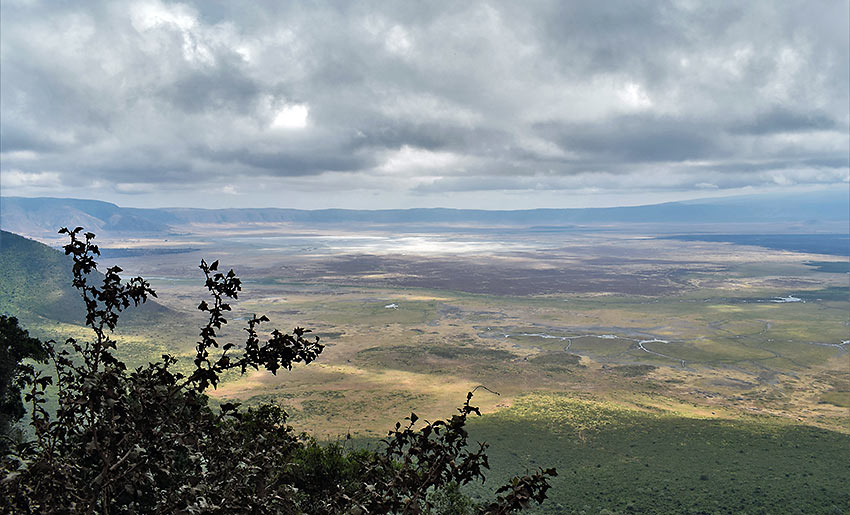
From the rim of the once volcano that erupted several million years ago and left the world’s largest dry caldera in its wake, the view across the 10-mile wide crater is spectacular. Surrounded by a continuous rim of what remains of the volcano, the valley below contains almost every species of east African animals except for the giraffe, which could never navigate its way down the steep slopes of the crater.
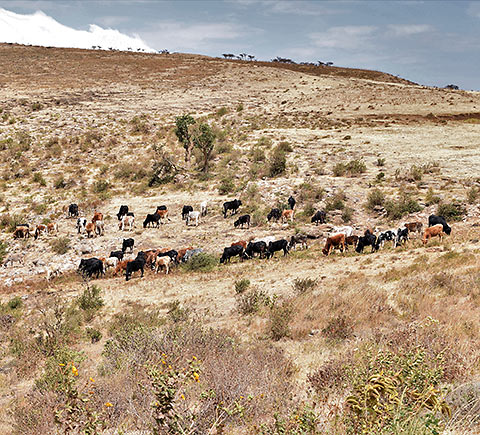 As we descended into the crater on a dirt road, we passed several Maasai villages and their herds of cattle. Years ago, the government of Tanzania took away much of the land claimed by the Maasai Tribes and turned the areas into national parks with the mandate that the tribes could not live in the national parks. Instead, the Maasai Tribes were relegated to live in the conservation areas that were established by the government. The Ngorongoro Crater is one such conservation area so the Maasai people have learned to live in harmony with wildlife that occupies the crater floor. Although the cattle roam freely, they are herded into corrals at night to keep the predators from having them for dinner.
As we descended into the crater on a dirt road, we passed several Maasai villages and their herds of cattle. Years ago, the government of Tanzania took away much of the land claimed by the Maasai Tribes and turned the areas into national parks with the mandate that the tribes could not live in the national parks. Instead, the Maasai Tribes were relegated to live in the conservation areas that were established by the government. The Ngorongoro Crater is one such conservation area so the Maasai people have learned to live in harmony with wildlife that occupies the crater floor. Although the cattle roam freely, they are herded into corrals at night to keep the predators from having them for dinner.
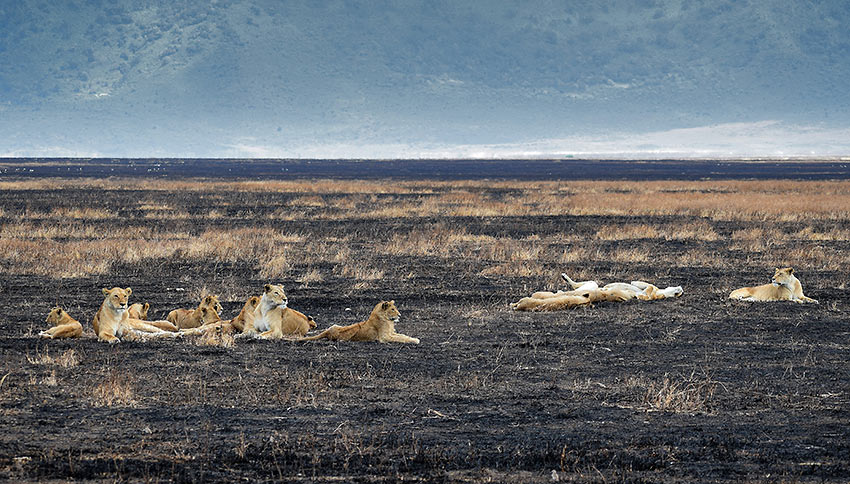
Once on the vast flat floor of the crater, there are dirt roadways that lead in all directions and numerous of safari vehicles. One of the popular lunch spots in the crater is the Hippo Pool, home to hundreds of hippos just lounging around in the large lake. Here we could get out of our vehicle to enjoy our box lunch along with other visitors and the hippos who obliged everyone by putting on shows of playfulness with each other. Although we ended up seeing all of the “Big Five” (the rhinos were a distance away and not reachable by vehicle due to the driving restrictions requiring vehicles to stay on the dirt roads), the crater itself was the main attraction. To see the vast number of animals all co-existing, at least during the day, was remarkable, but the sound of the wind blowing across the crater floor combined with the animal sightings was a moment to remember.
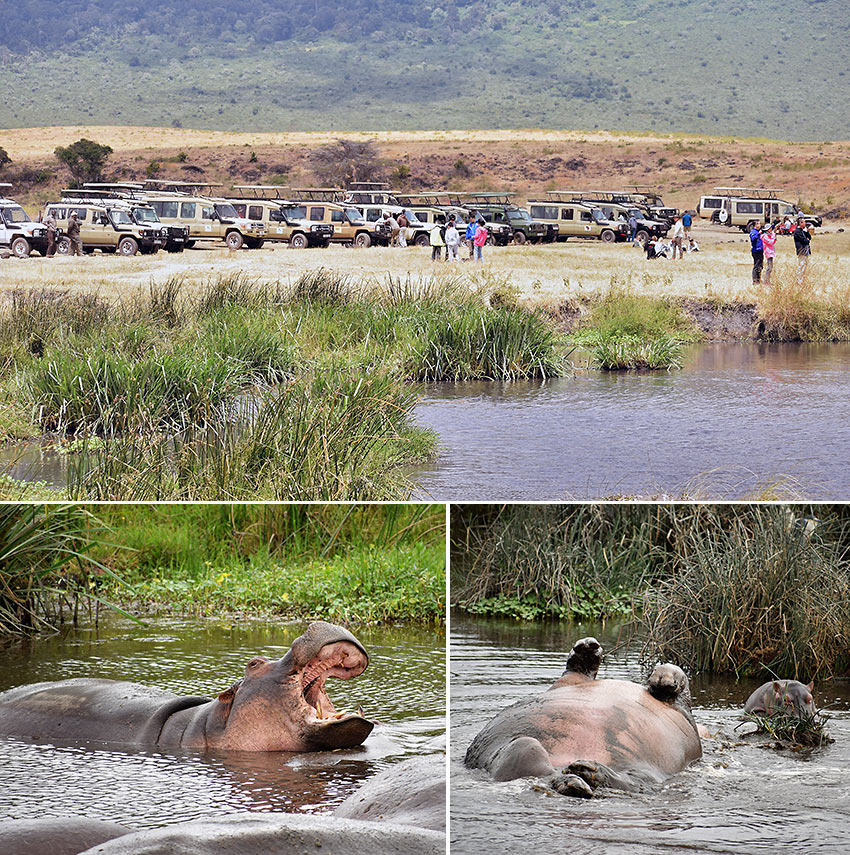
After spending several hours in the crater, it was time to make our ascent to our tented camp for the night before making our way to our next stop – the Serengeti. The word Serengeti is derived from the Maasai language and translates as “endless plain”. The name and the place were remarkable. Upon entering the Serengeti at the Naabi Hill Gate and climbing to the top of the local kopje, or rock outcropping, the views were as far as the eye could see. We stopped to pick up our permit, have a quick bite to eat and then set off to the central Serengeti for overnight stay at Ang’ata Serengeti Camp.
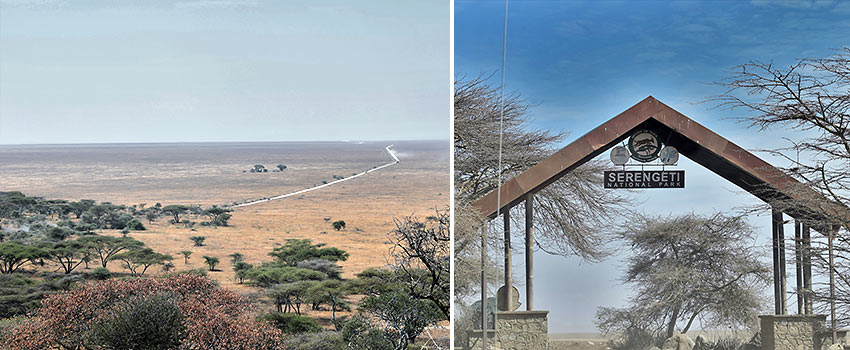
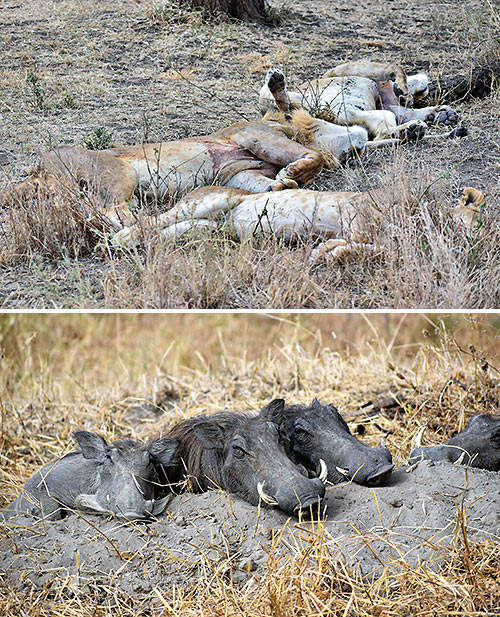 The drive to the camp over the usual dirt/gravel roads, traveled at about 40 MPH to help smooth out the rough road. The faster one drives, the less one feels all the ruts in the road. While this may be true because all the vehicles we saw along the way were traveling at this speed, unfortunately, what is sacrificed for relative comfort is given up for the endless dust, and the tsetse flies which somehow manage to get into the vehicle even at that speed. Our pop-top was open to keep the temperature inside the vehicle somewhat comfortable and to be able to view the variety of animals along the way, but a dust mask or a bandana would have helped to keep from inhaling the dust. I kept reminding my wife that we were in the Serengeti so deal with it – which she did quite admirably.
The drive to the camp over the usual dirt/gravel roads, traveled at about 40 MPH to help smooth out the rough road. The faster one drives, the less one feels all the ruts in the road. While this may be true because all the vehicles we saw along the way were traveling at this speed, unfortunately, what is sacrificed for relative comfort is given up for the endless dust, and the tsetse flies which somehow manage to get into the vehicle even at that speed. Our pop-top was open to keep the temperature inside the vehicle somewhat comfortable and to be able to view the variety of animals along the way, but a dust mask or a bandana would have helped to keep from inhaling the dust. I kept reminding my wife that we were in the Serengeti so deal with it – which she did quite admirably.
Several years ago, my wife, one of my daughters and I visited the ancient city of Petra in Jordan with its many rock carved buildings. After about a 45-minute walk through a gorge to get to the city, I was astonished to find a young man sitting on a camel talking on his cell phone. Well, hate to say it, but cell phone service is everywhere in the Serengeti too. Our driver got his share of calls, although most communication between vehicles is by radio.
One never knows what you’ll see along the route and this came true when we spotted a spitting black cobra in the middle of the road. Said explained that this cobra can spit its venom up to 10’ at the same time it lunges toward its prey. Needless to say, there were several vehicles stopped on the road just watching the cobra and not wanting to disturb it for fear of being its next victim. The venom can be deadly if it gets in your eyes or even on your skin. Fortunately, after about 10 minutes, it decided the show was over and slithered its way to the side of the road and was gone.
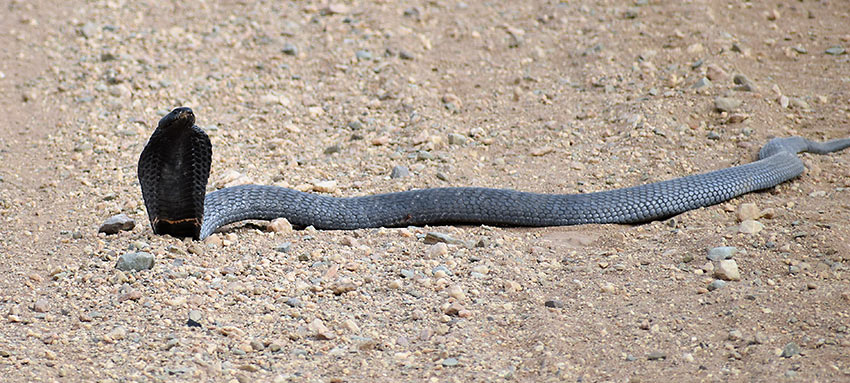
After an overnight stay in central Serengeti, we left camp early and headed for what we hoped would be the highlight of our safari – the Great Migration and river crossings in the north Serengeti. It’s hard to imagine thousands of animals roaming the plains, all with a common goal to search the fertile plains full of grasses that sustain their lives. This is the Great Migration and we were thrilled to witness it.
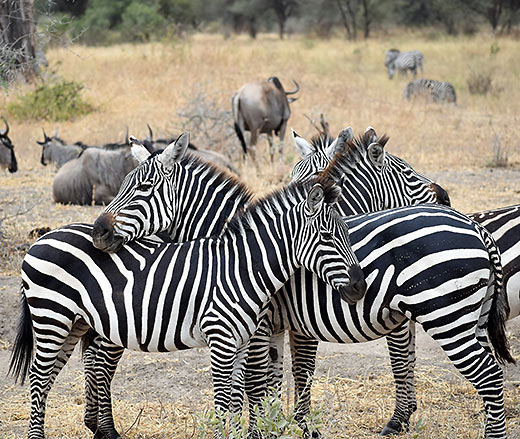 The wildebeests and zebras have a very symbiotic relationship. Generally when we came across a group of zebras, we would notice that while standing next to each other, one zebra would be looking left and the other looking right. When we asked Said about this anomaly, he told us that the zebras and wildebeests complement each other in a couple of ways. The reason the zebras are looking in different directions is because they have excellent eyesight and can spot predators off in the distance. The wildebeests, on the other hand, have excellent hearing and can distinguish the faintest sounds of approaching predators. Hence, the eyes and the ears working together help keep each other alert and alive. Also, the zebras eat the tall grasses while the wildebeests eat the shorter grasses. Got to love mother nature.
The wildebeests and zebras have a very symbiotic relationship. Generally when we came across a group of zebras, we would notice that while standing next to each other, one zebra would be looking left and the other looking right. When we asked Said about this anomaly, he told us that the zebras and wildebeests complement each other in a couple of ways. The reason the zebras are looking in different directions is because they have excellent eyesight and can spot predators off in the distance. The wildebeests, on the other hand, have excellent hearing and can distinguish the faintest sounds of approaching predators. Hence, the eyes and the ears working together help keep each other alert and alive. Also, the zebras eat the tall grasses while the wildebeests eat the shorter grasses. Got to love mother nature.
Wildebeests travel in herds that are led by one leader. From what we saw during our days in the north Serengeti, the herds varied from several hundred wildebeests to several thousand. So, imagine driving on a dusty road in the Serengeti, surrounded by nothing but endless plains and thousands of animals – wildebeests, zebras and gazelles. It is simply overwhelming and difficult to describe. As we drove through these herds towards the Mara River, the animals would scatter to the sides of the road, but amazingly staying with their herd as they followed the leader crossing the river on their way to the Masa Mara.
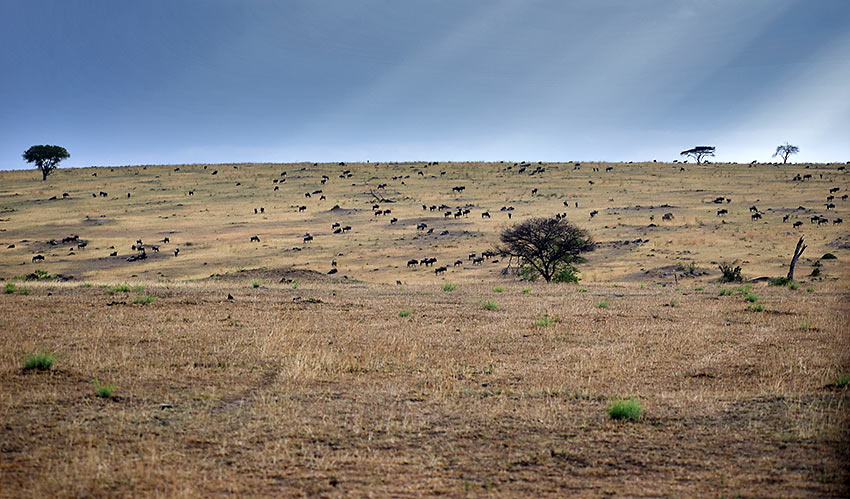
The Great Migration is a year-round event, but the river crossings only occur as the herds head north through the Serengeti from around June through September. There are about 16 known crossing points on the Mara River that are historically used by the herds. Call it instinct or just mother nature again, but these crossing points are well documented by the safari companies and their drivers. The drivers are constantly alerting each other via radio when it looks like a crossing is eminent.
There is an unspoken rule about waiting for a herd to cross. Herds are approaching the river every day during the months previously noted and the safari vehicles give them a wide berth so as not to disturb the leader’s pathway. When it’s evident that a leader is preparing to make its move to the river bank, all the vehicles hang back a few hundred yards, waiting along the tree line or the road that leads to the river. We witnessed a leader take its herd, numbering in the hundreds, to the water’s edge, then for some unknown reason, decide to turn away and walk back up the river bank to the plains. Why the leader and herd decided not to cross is just another mystery of nature.
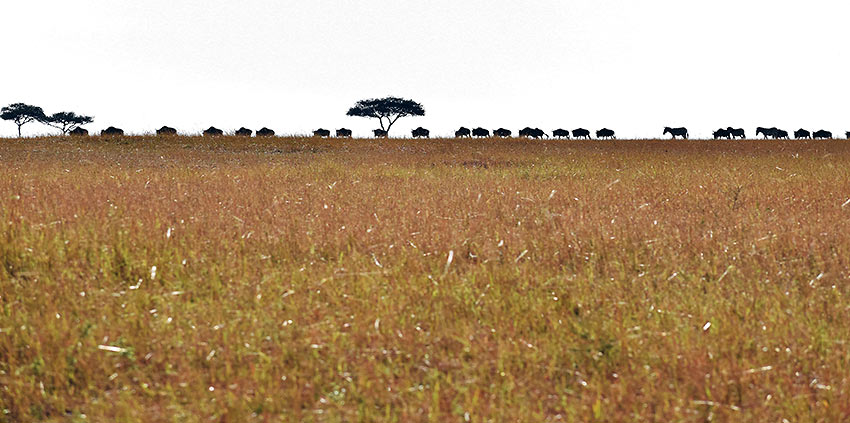
We spent the most of our first day at the river, riding up and down the river from location to location, in the hopes of seeing a crossing. Said assured us that he would eventually lead us to a crossing. The stars must have been aligned because we were not disappointed for long.
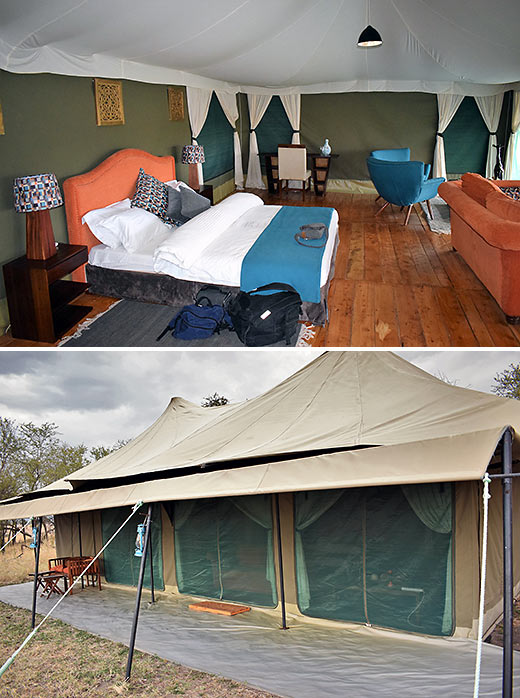 Our first night at Kazkas Mara Camp was extraordinary. From the front of our luxury tent, which was about the size of 3 hotel rooms, the plains were spread out before us and filled with herds of wildebeests and zebras as far as the eye could see. We knew that the herds were heading to the Mara River, but were probably two or three days away since our camp was about a 45-minute drive to the river.
Our first night at Kazkas Mara Camp was extraordinary. From the front of our luxury tent, which was about the size of 3 hotel rooms, the plains were spread out before us and filled with herds of wildebeests and zebras as far as the eye could see. We knew that the herds were heading to the Mara River, but were probably two or three days away since our camp was about a 45-minute drive to the river.
As in all the safari camps, one does not venture outside of one’s tent at night without an escort who was usually a Maasai tribesman. The reason is simple – during the day, the predators are used to seeing vehicles and people in the vehicles. At night, anything that moves may be the predator’s next meal so the Maasai have their flashlights and spears just in case there is a predator close by. The predators may stay away from the camps at night, but the wildebeests and zebras do not. Each night we would heard the wildebeests and zebra right outside our tent eating the grasses. They would snort and grunt to the point where we thought they were somehow inside the tent with us. Fortunately, we were told about these visitors at night so we were not completely freaked out when it happened.
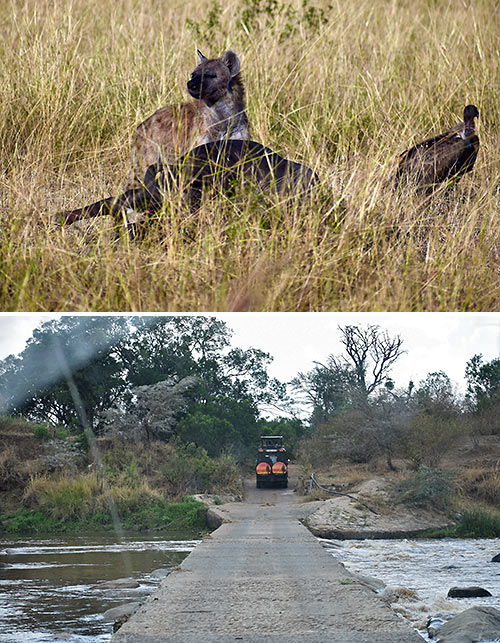 We got a 7:30 AM start the next morning and headed back to the river. On the way, we came across several hyenas who were enjoying a wildebeest that they had obviously killed during the night. We also stopped to watch a pride of lions, but we were anxious to get to the river which we did at 9:00. There is one “bridge” (more like an elevated concrete road with large gaps along it to let the river pass underneath) that crosses the Mara River at the Kogatende airstrip. Said apparently heard on the radio that a herd looked like it was getting ready to cross at a location on the opposite side of the river so we took a chance and drove about 20 minutes to the location. We were pleased for, shortly after arriving, a small herd of about 300 wildebeests followed its leader into the river and made the crossing. We were obviously excited at seeing our first river crossing although it only lasted about 10 minutes due to the size of the herd. Said then heard on the radio that another crossing looked like it was about to happen close by, so off we went to hopefully catch another crossing. We arrived in time to see our second crossing which looked to be about the same size herd as the first crossing except that there were zebras scattered about within the herd. As the herd crossed, the zebras seemed to hesitate as they entered the water and ended up turning around to where they started out. We never did see the zebras cross this time or any other time we spotted them close to the river.
We got a 7:30 AM start the next morning and headed back to the river. On the way, we came across several hyenas who were enjoying a wildebeest that they had obviously killed during the night. We also stopped to watch a pride of lions, but we were anxious to get to the river which we did at 9:00. There is one “bridge” (more like an elevated concrete road with large gaps along it to let the river pass underneath) that crosses the Mara River at the Kogatende airstrip. Said apparently heard on the radio that a herd looked like it was getting ready to cross at a location on the opposite side of the river so we took a chance and drove about 20 minutes to the location. We were pleased for, shortly after arriving, a small herd of about 300 wildebeests followed its leader into the river and made the crossing. We were obviously excited at seeing our first river crossing although it only lasted about 10 minutes due to the size of the herd. Said then heard on the radio that another crossing looked like it was about to happen close by, so off we went to hopefully catch another crossing. We arrived in time to see our second crossing which looked to be about the same size herd as the first crossing except that there were zebras scattered about within the herd. As the herd crossed, the zebras seemed to hesitate as they entered the water and ended up turning around to where they started out. We never did see the zebras cross this time or any other time we spotted them close to the river.
Some say we were lucky or probably in the right place at the right time, but we ended up seeing a total of six crossings that day. The best was saved for the last.
Before crossing back over the Mara River to the south banks, we came across a sighting that hadn’t come up in any conversations or in safari guide books. Hundreds of thousands of wildebeests cross the Mara River every year. Inevitably, many never make it across due to fatigue, age, too strong of a river current or attacks by the infamous Nile crocodiles. At one point, hundreds of these unfortunates got caught by rocks or other obstacles in the river and simply piled up against each other’s carcasses forming a dam of dead wildebeest bodies. Standing on top of the bodies were hundreds of vultures, feasting on the dead wildebeests. The smell of death was stifling to the point of choking, but the sighting was profound for its macabre reality. Mother nature once again at work.
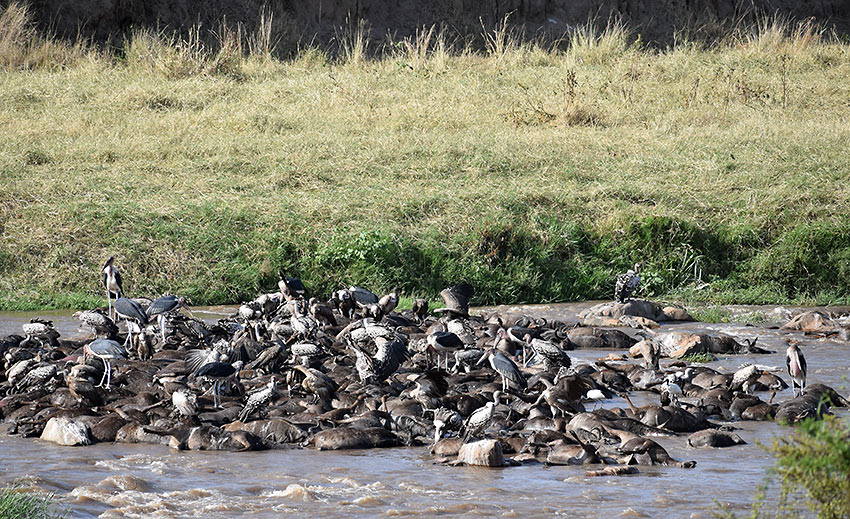
After crossing back over the Mara, we drove east along the river banks and were alerted by other drivers that a large herd was making its way to the river about a 20-minute drive away. Off we went in pursuit of another river crossing. We arrived to see a herd estimated at about three thousand following the leader along the river with what we hoped to be the intent to cross. As mentioned earlier, all the safari vehicles give a wide berth to a herd so as not to spook the leader and cause it to turn the herd away from the crossing. So, we waited patiently along with about 25 other vehicles, hoping for a huge crossing.
I’m not sure who sounded the alarm that the leader was heading down the embankment and into the water. Like a scene out of a Mad Max film, vehicles were charging out from their holding spots, making a hurried dash to the river to gain the best viewing spot available. Said did a good job manipulating our vehicle into a spot about 20 yards from the point of entry from which we could watch this incredible sight of hundreds of wildebeests stampeding into the river to swim, jump and maneuver across the river current. My Nikon also takes videos so I focused on the river and let the camera roll as the herd crossed and headed up the opposite bank to relative safety from the danger lying await in the river. Nothing it seemed would stop the continuous stream of animals. This was the first of four large herd crossings we saw that day, but the coup de gras was the last crossing of the day for we saw an encounter between a wildebeest and a Nile crocodile.
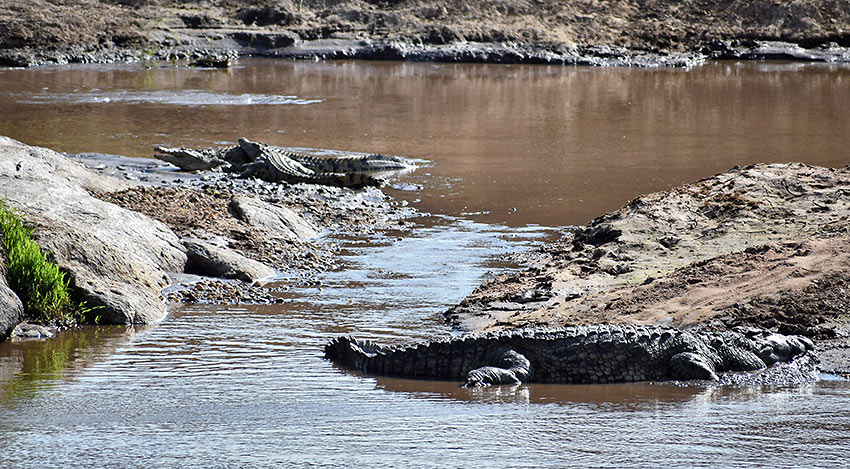
On occasion, one is lucky to see a crocodile come up out of the water and grab a wildebeest with its large jaws. A couple from Canada who was staying at our camp told us they witnessed such a killing. However, many battles between wildebeests and crocodiles happen quite differently as we observed during this last river crossing.
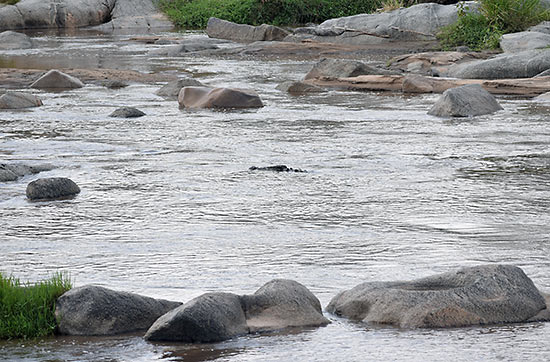 When a herd begins crossing, they stampede down the river bank to the opposite bank. Before you know it, the river is full of wildebeests maybe six to eight across, jumping over each other and any obstacles in their way. As we watched in amazement, I caught sight of a crocodile leaving its perch on a rock upstream and gliding into the water. I kept my camera’s video focused on the herd as the crocodile made its way closer and closer to the animals. I suddenly lost sight of the crocodile, but then noticed a wildebeest struggling to reach the opposite bank.
When a herd begins crossing, they stampede down the river bank to the opposite bank. Before you know it, the river is full of wildebeests maybe six to eight across, jumping over each other and any obstacles in their way. As we watched in amazement, I caught sight of a crocodile leaving its perch on a rock upstream and gliding into the water. I kept my camera’s video focused on the herd as the crocodile made its way closer and closer to the animals. I suddenly lost sight of the crocodile, but then noticed a wildebeest struggling to reach the opposite bank.
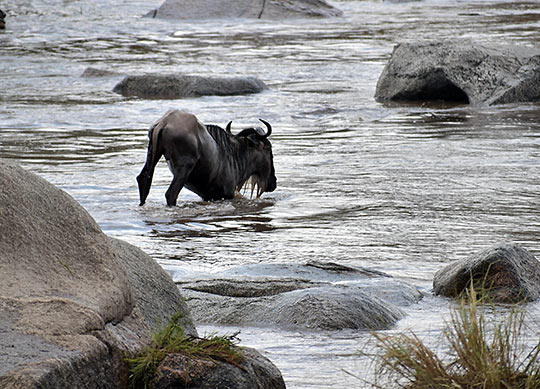 As I later learned, crocodiles will take hold of a wildebeest’s foot and hang onto the animal until it is exhausted and ultimately gives up its struggle to get free. Also, the Nile crocodiles only eat once a year when the migration crosses the river. For the rest of the year, they only eat small animals along the river banks or maybe a fish or two.
As I later learned, crocodiles will take hold of a wildebeest’s foot and hang onto the animal until it is exhausted and ultimately gives up its struggle to get free. Also, the Nile crocodiles only eat once a year when the migration crosses the river. For the rest of the year, they only eat small animals along the river banks or maybe a fish or two.
Back to the wildebeest that couldn’t escape from the jaws of the crocodile. Turns out that the wildebeest somehow got loose and made it to the opposite river bank, but as it left the river, I could see one of its legs barely hanging on its upper body. So, although it made it across, it would eventually die from loss of blood or be easy prey for a close predator.
For the thousands of wildebeest and occasional zebra that make it across the Mara River, the sacrifice of several hundred that don’t make it seem a small price to pay for the rest of the herd. Dangers still lie ahead for the herds that roam the Serengeti and the Masa Mara, for the predators are plentiful and have no problem finding their next meal.
The last crossing must have gone on for a good 30 to 40 minutes. I took video for about 10 minutes and finally shut off the camera so I could watch the seemingly endless stream of wildebeests charging into the river for their journey north. To see the herds crossing the Mara River is a natural phenomenon not to be missed if one goes on safari.
After a fantastic three days in north Serengeti, it was time to move on to our next destination – Victoria Falls. We said our goodbyes to the incredibly friendly people of Tanzania, and especially to Said, our driver and companion for the last eight days. We thanked him for all the animals we saw, watched, learned about and awed at, as well as the trek through the endless plains of the Serengeti. We vowed to hopefully return again one day to watch the Great Migration.
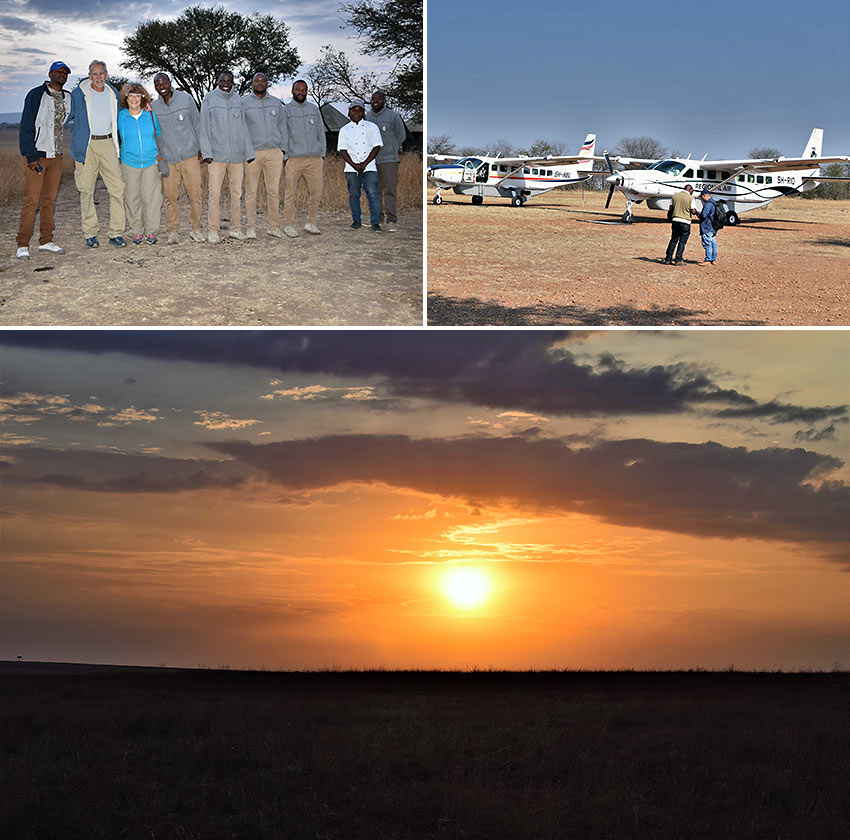
We then boarded our 10-passenger bush plane at the Kogatende airstrip and headed for Arusha.
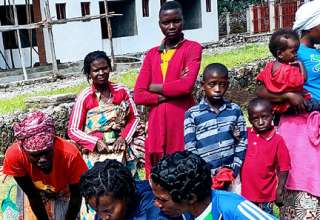

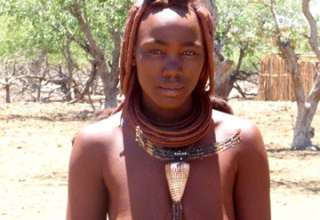


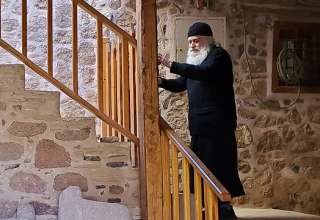

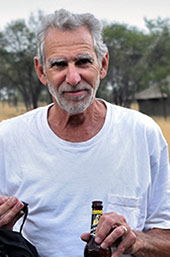 When not fixing something for someone, Steve Rosenfield is out exploring and sharing his travels as a freelance writer. Originally from Boston, Steve now lives in Los Angeles where he continues to reach out to all parts of the globe and report back about his latest adventure to whoever will listen. His stories help open up the world to those who wish they could visit, but have not yet found the time to experience other lifestyles and environments on their own.
When not fixing something for someone, Steve Rosenfield is out exploring and sharing his travels as a freelance writer. Originally from Boston, Steve now lives in Los Angeles where he continues to reach out to all parts of the globe and report back about his latest adventure to whoever will listen. His stories help open up the world to those who wish they could visit, but have not yet found the time to experience other lifestyles and environments on their own.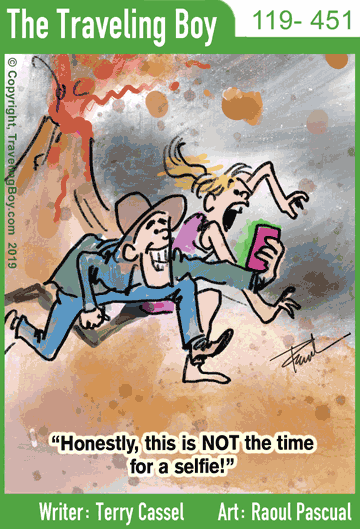
















Joel Polinsky
December 2, 2017 at 7:33 am
Steve-
Excellent article bravo. What an experience. Take me with you next time. Bravo to Ed and Elaine a real trooper from ‘Northridge to Africa’! Thanks…
-Joel
Jeff Bernards
December 20, 2017 at 10:10 pm
Great job of capturing the experience!! Thanks for sharing it.
Tanzania Safaris
January 27, 2020 at 3:02 am
Hi there. Thanks for this info! Love your blog!
African Safari
October 1, 2022 at 12:55 am
Beautiful post. Thank you for sharing.